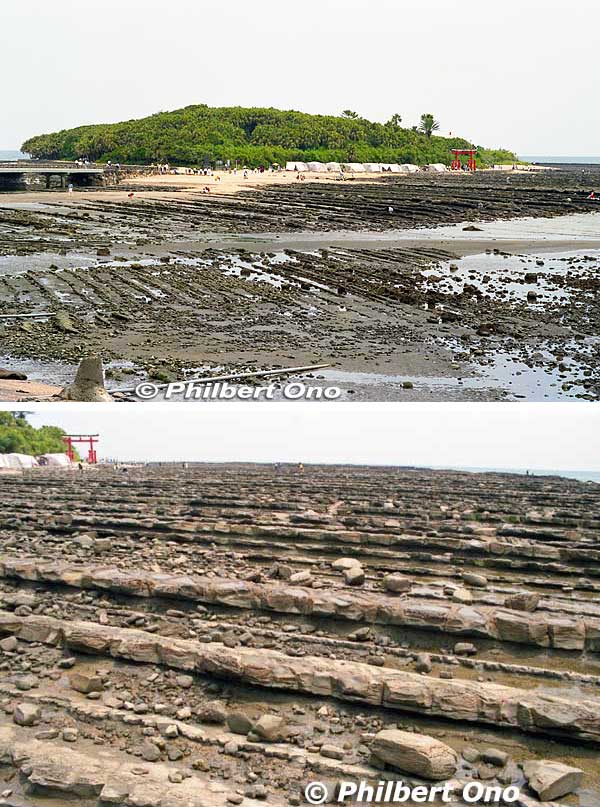
Miyazaki Prefecture’s most prominent natural feature are these neat parallel rows or grooves of pockmarked, platform rock nicknamed the “Devil’s Washboard” (鬼の洗濯板). They are uplifted wave-cut platforms (隆起波食台) formed by wave erosion. It does look like a giant washboard. You can see them along the Miyazaki coast and up close on Aoshima island, a short walk via bridge from shore. Unique enough to be designated as a National Special Natural Monument (国指定特別天然記念物).
Aoshima is a tiny, sandy outcrop on the middle of a large Devil’s Washboard rock island. It’s subtropical and has notable species of flora including the Chinese fan palm.
The island was once considered to be so sacred that ordinary folks were prohibited from visiting except during religious festivals. As indicated by the red torii, there’s a Shinto shrine on the island, Aoshima Shrine. The entire island is the shrine grounds. People come here to pray for a suitable marriage partner.
Aoshima became famous when Miyazaki Prefecture became a popular honeymoon destination among Japanese newlyweds in the 1960s to early 1970s.
Miyazaki Prefecture has an interesting chapter in Japan’s travel history, especially for honeymoon travel. It started in 1960 when Emperor Hirohito’s fifth daughter and youngest child Princess Takako (1939– ) got married and decided to honeymoon in Miyazaki with her husband Shimazu Hisanaga (1934– ), a grandson of the last daimyo of the Satsuma Domain (Kagoshima Prefecture).
Princess Takako (officially named “Princess Suga”) received much media attention for her outgoing and bright personality. Her marriage came soon after her brother and future emperor Akihito’s marriage to Michiko in 1959. It was a striking contrast between a commoner (Michiko) becoming a princess and a princess (Takako) becoming a commoner through marriage. In accordance with the new law, Takako was actually the first female member of the Imperial family to marry a commoner and lose her Imperial status.
Takako and her husband visited Miyazaki mainly to visit the graves of his Shimazu relatives. They arrived Miyazaki on a luxury passenger ship from Kobe. The couple also visited Aoshima island. The mass media followed them around and showed them enjoying their honeymoon in Miyazaki and Kagoshima Prefectures.
Their visit sparked a Miyazaki honeymoon boom among wedded Japanese couples from the 1960s to early 1970s. Miyazaki played up its semi-tropical look and feel with flora (Phoenix palm trees and cactus), blue ocean, long sunny days, and even camel rides. It was a time before overseas travel (i.e. Hawaii) was still prohibited for Japanese tourists and before Okinawa was returned to Japan.
The Miyazaki honeymoon boom peaked in 1974 when 35 percent of all newlywed Japanese couples honeymooned in Miyazaki. It greatly boosted Japan’s domestic air travel from 1.25 million airline passengers in 1960 to 5 million in 1965 when many couples flew to dreamy Miyazaki. Of course, they all visited Aoshima too.
Soon after Okinawa reverted to Japan in 1972, Miyazaki was replaced by Okinawa as Japan’s top honeymoon destination. A few years later, Hawaii became No. 1. Japan’s love affair with Hawaii continues. I feel sorry for Miyazaki though. ![]()
More photos of Aoshima: https://photoguide.jp/pix/thumbnails.php?album=426
![]() Short walk from JR Aoshima Station on the JR Nichinan Line.
Short walk from JR Aoshima Station on the JR Nichinan Line.
Official: https://aoshima-jinja.jp/